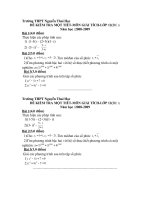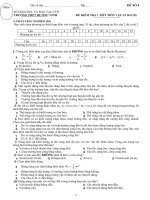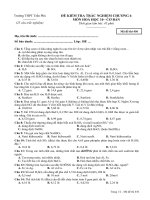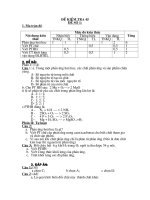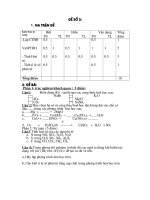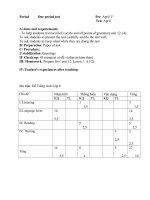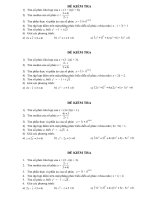DE KIEM TRA MOT TIET SO 3
Bạn đang xem bản rút gọn của tài liệu. Xem và tải ngay bản đầy đủ của tài liệu tại đây (165.32 KB, 10 trang )
TRƯỜNG THPT THANH THỦY
Họ và tên : .........................................................
Lớp : 12 A.......
ĐỀ KIỂM TRA 1 TIẾT SỐ 3
MÔN: TIẾNG ANH 12 (2016 – 2017) Thời gian : 45 phút
ĐIỂM
Mark the letter A, B, C or D to indicate the word whose underlined part differs from the other three in
pronunciation in each of the following question:
1. A. killed
B. enjoyed
C. described
D. digested
2. A. swallow
B. below
C. slowly
D. allow
3. A. bamboo
B. good
C. foot
D. cook
Mark the letter A, B, C or D to indicate the word that differs from the other three in the position
of the primary stress in each of the following questions
4. A. reserve
B. schedule
D. wildlife
D. beauty
5. A. derive
B. contain
D. leopard
D. prevent
Mark the letter A, B, C or D to indicate the correct answer to each of the following questions:
6. Many plants and endangered species are now in danger of…………………
A. expression
B. expulsion
C. extinction
D. extension
7. . ………………is destroying large areas of tropical rain forests.
A. Disforestation
B. Deforestation
C. Anti-forestation D. Forests
8. A lot of different conservation efforts have been made to……………..endangered species.
A. save
B. kill
C. make
D. do
9. The raw sewage needs to be………………treated.
A. chemically
B. chemical
C. chemist
D. chemistry
10. There are more than 20……………….working on the water treatment project.
A. researches
B. researcher
C. researchers
D. research
11. Pay attention…………..all traffic signs when you travelling in the street.
A. for
B. on
C. to
D. from
12. Their plans were cancelled…………. of a bad storm.
A. in spite
B. because
C. instead
D. in place
13. I’ll lend you the money and you…………pay me back till next month.
A. needn’t
B. mustn’t
C. need
D. must
14. After the operation, patients may find it difficult to chew and………….
A. breathe
B. swallow
C. digest
D. drink
15. Up to the present, we………….almost every lesson on the book.
A. had written
B. have written
C. are writing
D. wrote
16. The old building………………down.
A. is being pulled
B. are pulled
C. pulls
D. pulled
17. Those letters ________ now. You can do the typing later.
A. need typing
B. needn't be typed C. need to type
D. needn't typing
18. We spend more time watching TV than reading books. But ___ fact, TV has not killed
reading.
A. for
B. on
C. at
D. in
Mark the letter A, B, C or D to indicate the correct response to each of the following exchanges
19. Jane: “Thank you for the lovely present.” Mike: “___________________.”
A. Go ahead
B. Not at all
C. Come on
D. I’m pleased you like it
20. Peter: “Do you feel like going to the cinema this evening?”
Mary: “___________.”
A. I don’t agree. I’m afraid.
B. You’re welcome
C. That would be great
D. I feel very bored
1.
2.
3.
4.
5.
6.
7.
8.
9.
10.
11.
12.
13.
14.
15.
16.
17.
18.
19.
20.
21.
22.
23.
24.
25.
26.
27.
28.
29.
30.
31.
32.
33.
34.
35.
36.
37.
38.
39.
40.
Mark the letter A, B, C or D to indicate the word(s) SIMILAR in meaning to the underlined word(s) in
each of the following questions.
21. Please give me some advice to buy suitable books for my ten-year-old girl.
A. recommendation B. information
C. fiction
D. interest
22. The Bali Tiger was declared extinct in 1937 due to hunting and habitat loss.
A. reserve
B. generation
C. diversity
D. natural environment
Mark the letter A, B, C or D to indicate the underlined part that needs correction in each of the following
questions.
23. Have you ever read any novels writing by Jack London?
A
B C
D
24. I am not working tomorrow, so I mustn’t get up early.
A
B
C
D
25. My uncle has just bought some expensive furnitures for his new house.
A
B
C
D
Mark the letter A, B, C, or D to indicate the sentence that is closest in meaning to each of the following
questions.
26. He last had his car repaired 2 weeks ago.
A. He hasn’t had his car repaired for 2 weeks.
B. He had repaired his car 2 weeks before.
C. He had not repaired his car for 2 weeks then.
D. He didn't have any repair to his car in 2 weeks.
27. John lent me this book.
A. This book was lent to me by John.
B. I lent this book to John.
C. This book is lent to me by John.
D. I was lent by John this book.
28. They had seen the man in a parking lot.
A. The man was seen in a parking lot.
B. The man has been seen in a parking lot.
C. The man was to be seen in a parking lot.
D. The man had been seen in a parking lot.
29. The gate was closed to stop the children running into the road.
A. The gate was closed so the children running into the road.
B. The gate is closed so that children don’t run into the road.
C. The gate was closed so that the children couldn’t run into the road.
D. The gate is closed that the children couldn’t to run into the road.
30. My Indian friend finds using chopsticks difficult.
A. My Indian friend is not used to using chopsticks.
B. My Indian friend can’t use chopsticks.
C. My Indian friend didn’t use to using chopsticks.
D. It is so difficult to use chopsticks that my friends can’t use it.
Read the following passage and mark the letter A, B, C, or D to indicate the correct word or phrase that
best fits each of the numbered blanks.
In the past, elephants in Thailand were taken from the wild when they were very young. They (31)
__________ to work for the people cutting down the large trees of the forests. They became “work machine”
– they were not free, wild animal (32) __________ more.
Some of the elephants became depressed and some even cried. Elephants can be unhappy too.
Boualoi was one of these elephants, (33) __________with the help of Thailand’s Royal Family and the World
Wildlife Fund, she is soon going back (34) __________ her natural environment, the forest. First, she is going
to live at the Doi Pa Muang Wildlife Sanctuary. There, she will learn (35) __________ free again, and she
will meet other free elephants for the first time.
31. A. sell
B. sold
C. are sold
D. were sold
32. A. some
B. little
C. any
D. few
33. A. for
B. but
C. since
D. as
34. A. in
B. on
C. from
D. to
35. A. be
B. to be
C. being
D. to have been
Read the following passage and mark the letter A, B, C or D to indicate the correct answer to each of the
questions.
There are books with fairy tales in many countries. Often the same stories are known and repeated in many
languages. Some of the things that happen in these stories are remarkable, although not as remarkable as
things that are truly happening in medicine and science today.
Most fairy tales begin with “Once upon a time…” and end with “They lived happily ever after”, so we will
begin in the same way.
Once upon a time there was a girl called Cinderella who did all the work in the kitchen while her lazy sisters
did nothing.
One night, her sister went to a ball at the palace. Cinderella was left home, very sad. After a time her fairy
godmother appeared and told Cinderella that she could go to the ball- but to return home by midnight.
So she went to the ball in a beautiful dress in a wonderful coach. She danced with the prince but at midnight
she ran back home, leaving one of her shoes on the floor. The prince wanted to see her again and went to
every house in the capital until he found that the shoe was the right size for Cinderella. She and the price were
married and lived happily ever after.
36. Books with fairy are found in ________________.
A. our country only
B. few countries
C. all countries except ours
D. many countries
37. According to the passage, things truly happening in medicine and science today are_________ things
that happen in some fairy tales,
A. More remarkable than
B. less remarkable than
C. as remarkable as
D. not as remarkable as
38. The word “ball” in the first sentence means ________________.
A. a sport equipment B. a dancing hall
C. a balloon
D. sphere
39. Cinderella was very sad because ________________.
A. her sister did nothing
B. her sister went to a ball and left her at home
C. she did all the work in the kitchen
D. her sister was invited to a hall
40. At the end of the story ________________.
A. Cinderella could go to the ball and it was so happened that she and the prince was married
B. Cinderella’s godmother came to comfort her
C. one of Cinderella’ sisters was married to the prince
D. the prince invited Cinderella to the hall
TRƯỜNG THPT THANH THỦY
ĐỀ KIỂM TRA 1 TIẾT SỐ 3
MÔN: TIẾNG ANH 12 (2016 – 2017) Thời gian : 45 phút
ĐIỂM
Họ và tên : .........................................................
Lớp : 12 A.......
Mark the letter A, B, C or D to indicate the word whose underlined part differs from the other three in
pronunciation in each of the following question:
1. A. same
B. taste
C. swallow
D. page
2. A. sleep
B. keep
C. pleasure
D. people
3. A. too
B. book
C. look
D. good
Mark the letter A, B, C or D to indicate the word that differs from the other three in the
position of the primary stress in each of the following questions
4. A. subject
B. swallow
C. story
D. digest
5. A. example
B. holiday
C. careful
D. interest
Mark the letter A, B, C or D to indicate the correct answer to each of the following questions:
6. .........that the hope for cancer control may lie in the use of vaccine.
A. To believe
B. It is believed
C. Believing
D. The belief
7. My roommate's handwriting was very bad, so he had me........ his paper for him last night.
A. to type
B. type
C. to have typed
D. typed
8. Would you be........to hold the door open?
A. too kind
B. as kind
C. kind enough
D. so kind
9. Two parallel white lines in the middle road meant that you _________ overtake.
A. mustn’t
B. might
C. can’t
D. need
10. Children are........in watching cartoon films.
A. interested
B. keen
C. fond
D. concerned
11. The ........thing about travelling by train rather than by car is that you can sleep or read
during the journey.
A. enjoyment
B. enjoyed
C. enjoying
D. enjoyable
12. I wonder who drank all the milk yesterday. It........ have been Jane because she was out all
day.
A. must
B. could
C. needn't
D. can't
13. Books in the home are a wonderful....... of knowledge and pleasure.
A. source
B. resource
C. list
D. sum
14. Books are still a cheap........ to get knowledge and entertainment.
A. means
B. way
C. method
D. measure
15. A fine tomb,........, marks the grave of the poet Chaucer.
A. which in the fifteenth century was erecting
B. erecting in the fifteenth century
C. erected in the fifteenth century
D. being erected in the fifteenth century
16. More and more people __________ of food poisoning nowadays.
A. exits
B. survive
C. die
D. starve
17. Bring your jacket with you. It ______ get cold in the evening.
A. can
B. must
C. may
D. would
18. He has refused, but he _________ change his mind if you asked him again
A. might
B. may
C. can
D. must
Mark the letter A, B, C or D to indicate the correct response to each of the following exchanges
19. Jane: “Thank you for the lovely present.” Mike: “___________________.”
A. Go ahead
B. Not at all
C. Come on
D. I’m pleased you like it
20. Peter: “Do you feel like going to the cinema this evening?”
1.
2.
3.
4.
5.
6.
7.
8.
9.
10.
11.
12.
13.
14.
15.
16.
17.
18.
19.
20.
21.
22.
23.
24.
25.
26.
27.
28.
29.
30.
31.
32.
33.
34.
35.
36.
37.
38.
39.
40.
Mary: “____________________.”
A. I don’t agree. I’m afraid.
B. You’re welcome
C. That would be great
D. I feel very bored
Mark the letter A, B, C or D to indicate the word(s) SIMILAR in meaning to the underlined word(s) in
each of the following questions.
21. It is found that endangered species are often concentrated in areas that are poor and densely populated,
such as much of Asia and Africa.
A. disappeared
B. increased
C. threatened
D. reduced
22. Although the government has taken certain measures to protect elephants, numerous threats remain for
them.
A. too much
B. a lot of
C. some
D. a few
Mark the letter A, B, C or D to indicate the underlined part that needs correction in each of the following
questions.
23. Lack of properly physical exercise cause tiredness and poor health.
A
B
C
D
24. You mustn’t do this exercise if you don’t want to. It is optional.
A
B
C
D
25. My parents often take careful of me when I am ill.
A
B
C
D
Mark the letter A, B, C, or D to indicate the sentence that is closest in meaning to each of the following
questions.
26. People say that prevention is better than cure.
A. It is said that prevention is better than cure.
B. Prevention is said to be better than cure.
C. Prevention is to have said to be better than cure.
D. A and B are correct.
27. My mother gave a watch to me.
A. My mother was given a watch by me.
B. A watch was given to me by my mother.
C. A watch was given my mother by me.
D. A watch was given to my mother by me.
28. Too tired to continue, David stopped walking.
A. David couldn’t carry on walking because he was too tired.
B. David couldn’t stop walking because he was to tired.
C. David was too tired to carry out walking.
D. David can’t continue to walk when he’ stirred.
29. I haven’t met old English teacher since I left school.
A. I didn’t have a chance to meet my old English teacher because I left school.
B. this is the last time I met my old English teacher at school.
C. I last met my old English teacher when I left school.
D. My old English teacher hasn’t met me since I have left school.
30. Tom didn’t begin to read until he was eight.
A. It was not until Tom was eight that he began to read.
B. When Tom was eight, he didn’t know how to read.
C. Tom had read when he was Wight to read.
D. Not until Tom read, he was eight.
Read the following passage and mark the letter A, B, C, or D to indicate the correct word or phrase that
best fits each of the numbered blanks.
Nowadays people are more aware that wildlife all over the world is in (31) __________. Many species of
animals are threatened, and will easily become extinct if we do not make an effort to (32) __________them.
There are many reasons for this. Animals are hunted for their fur or for other valuable parts of their bodies.
Some birds, such as parrots, are caught and sold as pets.
For many animals and birds, the problem is that their (33) _____ – the place where they live – is disappearing.
More land is used for farms, for houses or industry. Farmers (34) ________ powerful chemicals to help them
grow better crops, but these chemicals pollute the environment and harm wildlife. The most successful
animals on earth – human beings – will soon be the only ones left (35) _______ we can solve this problem.
31. A. danger
B. threat
C. problem
D. vanishing
32. A. harm
B. ensure
C. serve
D. protect
33. A. place
B. house
C. habitat
D. cage
34. A. use
B. are used
C. used
D. don’t use
35. A. because
B. however
C. if
D. unless
Read the following passage and mark the letter A, B, C or D to indicate the correct answer to each of the
questions.
Will people still read books 100 years from now? A few years ago, many people would have said no. It
seemed likely that computers and the Internet would replace books. Now, however, most experts think that
books are here to stay.
There are a number of reasons why computers will not replace books entirely. One reason is that books on
paper are much cheaper than computers. And books do not need a power source. You can read a book for as
long as you want and wherever you want. You never have to worry about losing power. Also, many people
feel more comfortable reading words in a book than reading words on a computer screen because it is less
tiring to the eyes.
Will books in the future be exactly the same as the books you can buy today? The answer to that question is
no. In the future, you may only need to buy one book. With this one book, you will be able to read novels,
plays, and newspapers. It will look like today's books, but it will be electronic.
One of the people working on the book of the future is Professor Joseph Jacobson from Massachusetts
Institute of Technology. Professor Jacobson's electronic book will have a small button on the side. When you
press the button, words will instantly appear on the page. When you want to read a different story, you can
push the button again and a new story will quickly appear.
36. The phrase “are here to stay” in the first paragraph mostly means ………… .
A. “are useless”
B. “won’t come”
C. “are nearby”
D. “won't disappear”
37. Which of the following is TRUE according to the passage?
A. Books will disappear completely sooner or later.
B. In the future, computers will replace paper books completely.
C. Reading words on computer screens is tiring to the eyes.
D. Reading today’s books needs a power source.
38. What will the book of the future look like?
A. It will look like a book you buy today.
B. It will look different from today's books.
C. We don't know what it will look like.
D. It will look like a computer.
39. The button on the side of the electronic book is used ………… .
A. to turn a light on and off
B. to make the book more beautiful
C. to turn the power on and off
D. to change what you read
40. What is the main topic of the passage?
A. How to use an electronic book.
B. Why a power source is important.
C. The book of the future.
D. The decline of today's book
CẤU TRÚC, MỨC ĐỘ NHẬN THỨC VÀ PHÂN BỔ NỘI DUNG CỦA MA TRẬN
BÀI KIỂM TRA 1 TIẾT SỐ 3 LỚP 12 NĂM HỌC 2016 – 2017
KIẾN THỨC
NĂNG LỰC/ KỸ
NĂNG
CÂU
SỐ
1.
2.
1. PHONETICS
Số câu: 5
Số điểm: 1,25
Tỉ lệ %: 12,5
3.
4.
5.
2. GRAMMAR
AND
VOCABULARY
6.
7.
8.
Số câu: 20
Số điểm: 5
Tỉ lệ %: 50
9.
10.
11.
12.
13.
MỨC ĐỘ
NHẬN THỨC
CHUẨN KTKN
Thông hiểu
Thông hiểu
Thơng hiểu
Thơng hiểu
Thơng hiểu
Thơng hiểu
Nhận biết
Thơng hiểu
NĂNG LỰC NGƠN
NGỮ
CẦN ĐẠT
MCQs
Chọn từ mà phương
thức phát âm/ trọng
âm khác với từ con
lại trong nhóm
Thơng hiểu
Thơng hiểu
DẠNG CÂU
HỎI
MCQs
MCQs
Kiểm tra khả phương
thức phát âm ,trọng âm
của từ
MCQs
MCQs
- Cách sử dụng must,
needn’t, mustn’t,
may, might
- Cách dùng thể bị
động với các thì
khác nhau.
Nắm vững và sử
dụng từ vựng đã học
ở bài 10,11.
MCQs
MCQs
MCQs
MCQs
MCQs
Thông hiểu
MCQs
Thông hiểu
MCQs
Thông hiểu
MCQs
Nhận biết và nắm vững
cách sử dụng một số
modal verbs, passive
voice
Nhận biết và nắm vững
được cách sử dụng từ
vựng đã học
NĂNG LỰC GIAO TIẾP
CẦN ĐẠT
Sử dụng modal verbs, pasive
voice trong câu phù hợp.
Đọc hiểu , nắm được ý chính
và chi tiết trong đoạn văn.
Sử dụng từ vựng phù hợp
với nghĩa của câu và văn
cảnh cụ thể.
Hiểu và nắm vững phương
thức phát âm của từ đã học.
Hiểu và nắm vững các cấu
trúc câu khác nhau để có thể
chọn được câu có nghĩa
tương đương.
14.
15.
16.
17.
18.
19.
20.
21.
22.
23.
24.
25.
2. WRITING
SENTENCE
LEVEL
Số câu: 5
Số điểm: 1,25
Tỉ lệ %:12,5
26.
27.
28.
29.
Vận dụng
MCQs
Vận dụng
MCQs
Nhận biết
MCQs
Nhận biết
MCQs
Nhận biết
MCQs
Thông hiểu
MCQs
Thông hiểu
MCQs
Thông hiểu
MCQs
Nhận biết
MCQs
Nhận biết
MCQs
Nhận biết
MCQs
Nhận biết
MCQs
Thông hiểu
Thơng hiểu
Nhận biết
Thơng hiểu
- Chọn một câu có
nghĩa tương đương
với câu đã cho, kiểm
tra cấu trúc ngữ pháp
và cách sử dụng các
cụm từ của học sinh
MCQs
MCQs
MCQs
MCQs
Sử dụng kiến thức kỹ
năng ngôn ngữ để chọn
câu gần nghĩa với câu đã
cho
30.
31.
32.
33.
34.
35.
3. READING
+ READING 1
+ READING 2
Số câu: 10
Số điểm:2,5
Tỉ lệ %:25
36.
37.
38.
39.
40.
TNKQ: 40
Nhận biết: 12 câu = 30 %
MCQs
Thông hiểu
Nhận biết
MCQs
Nhận biết
MCQs
Thông hiểu
MCQs
Nhận biết
Vận dụng
Thông hiểu
Thông hiểu
Vận dụng
Thông hiểu
- Đọc và đốn nghĩa
từ vựng theo ngữ
cảnh, tìm ý chính
của đoạn văn, tìm ý
tổng qt của cả
đoạn, tìm thơng tin
chi tiết
- Đọc một đoạn văn
chọn đáp án phù hợp
để điền vào ô trống,
kiểm tra khả năng sử
dụng từ vựng và cấu
trúc ngữ pháp.
Thông hiểu
Thông hiểu: 24 câu = 60 %
MCQs
MCQs
MCQs
MCQs
MCQs
MCQs
MCQs
MCQs
MCQs
MCQs
MCQs
MCQs
Vận dụng: 4 câu= 10
- Đọc một đoạn văn dựa
vào các kiến thức hiểu
biết về cấu trúc ngữ pháp,
từ vựng đã học để chọn
đáp án phù hợp điền vào
các chỗ trống trong đoạn
văn
- Nắm được bố cục, cấu
trúc, kỹ thuật nối văn bản
của một bài đọc có độ dài
khoảng 230 đến 250 từ
để lấy thông tin cần thiết
